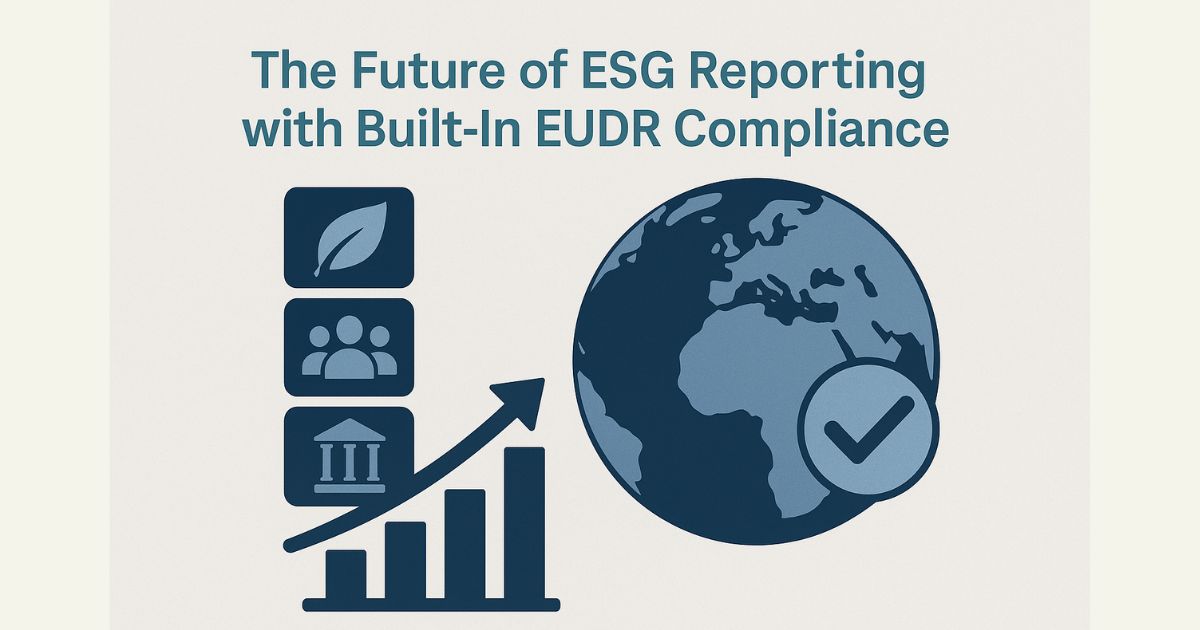In recent years, Environmental, Social, and Governance (ESG) reporting has gained unprecedented momentum, becoming a core component of corporate strategy and investor decision-making. As global regulations tighten and stakeholders demand greater transparency, businesses are turning to advanced technologies to streamline sustainability efforts. One of the most significant developments shaping the future of ESG reporting is the integration of EUDR compliance—a vital move for companies operating in or exporting to the European Union. Leveraging EUDR Compliance Software within ESG platforms is rapidly becoming a necessity, not a luxury.
Understanding ESG Reporting in a Regulatory World
ESG reporting encompasses the communication of information regarding a company’s effects on the environment, its social responsibilities, and its governance practices. Initially a voluntary exercise, ESG disclosure is now mandated or strongly encouraged by multiple jurisdictions. Investors and regulators alike want to see credible, consistent, and verifiable data.
Yet, producing quality ESG reports is no small task. The process involves collecting massive volumes of data from diverse departments, aligning them with industry-specific standards, and maintaining a strong audit trail. This is where technology plays a transformative role—helping automate data collection, ensure standard compliance, and provide real-time analytics.
The Rising Significance of EUDR
The European Union Deforestation Regulation (EUDR), which will take effect in 2024, mandates that businesses placing commodities and products in the EU market must guarantee they are not associated with deforestation or degradation of forests. Products such as soy, palm oil, wood, cocoa, coffee, and cattle—and derived goods—must be fully traceable to their source.
The EUDR introduces new layers of complexity to ESG reporting. Organizations must now submit detailed due diligence statements and ensure geo-location data of origin plots, robust supply chain tracking, and risk assessments. Failing to comply may result in fines, reputational damage, or market exclusion.
Bridging ESG Reporting and EUDR Compliance
Traditionally, ESG reporting and regulatory compliance were treated as separate functions. However, the boundaries are now blurring. The integration of EUDR requirements into ESG frameworks allows for more coherent reporting and simplified data governance. This fusion not only minimizes redundancy but also aligns environmental goals with legal obligations.
Companies that act now to embed EUDR-related checkpoints into their ESG strategy are likely to gain a competitive edge. They demonstrate proactive stewardship, which is increasingly valued by both consumers and institutional investors.
The Role of ESG Reporting Software
Modern ESG Reporting Software is designed to manage complexity with ease. These platforms go far beyond data visualization—they offer a full suite of tools for tracking performance indicators, aligning with global frameworks like GRI, SASB, or TCFD, and automating audit trails.
Now, the best platforms are evolving to include built-in EUDR modules. These modules help businesses:
- Trace product origin using geolocation and satellite imaging
- Automate risk analysis based on deforestation data and region-specific risk maps
- Generate due diligence reports as per EUDR specifications
- Monitor supplier compliance through integrated data-sharing protocols
By unifying ESG and EUDR data within one interface, businesses can drastically reduce time and resource expenditure while improving data accuracy and compliance readiness.
Benefits of Built-In EUDR Compliance
Incorporating EUDR features into ESG platforms brings multiple advantages:
1. Streamlined Data Collection
Instead of maintaining separate systems for sustainability and compliance, organizations can centralize all reporting efforts. This reduces duplication, lowers administrative overhead, and ensures cohesive narratives across reports.
2. Better Risk Management
With EUDR compliance integrated into ESG software, companies can anticipate regulatory risks before they escalate. Real-time alerts and automated checks ensure no deforestation-linked commodity slips through unnoticed.
3. Transparency and Trust
Unified reporting builds credibility with investors, regulators, and consumers. It signals that the company not only complies with the law but also cares about sustainable practices.
4. Faster Market Access
Regulatory readiness ensures companies face fewer delays or penalties when entering the EU market. Those that meet EUDR requirements efficiently will benefit from smoother operations and enhanced reputation.
Challenges and Considerations
While the benefits are substantial, integration is not without its challenges. Companies must ensure:
- Data accuracy: False geolocation data or incomplete supplier information can lead to non-compliance.
- Scalability: The software must handle large volumes of complex data without lagging.
- Supplier cooperation: Smaller suppliers may lack the digital infrastructure to provide compliant data.
To address these, companies need scalable, cloud-based platforms that support real-time collaboration and supplier engagement features.
Looking Ahead: Future Trends
As ESG expectations grow and regulations expand, the future will likely see:
- AI-powered compliance checks that assess supplier risks automatically
- Blockchain for supply chain traceability, ensuring immutable data logs
- Interoperable platforms that connect ESG data with financial systems for unified corporate reporting
Moreover, the convergence of regulations like EUDR, CSRD (Corporate Sustainability Reporting Directive), and the EU Taxonomy will push companies toward more integrated digital ecosystems.
Conclusion
The incorporation of EUDR compliance into ESG reporting represents a crucial advancement in the development of corporate sustainability. Businesses that embrace this shift now are not just ensuring legal compliance—they are building smarter, more resilient, and transparent operations for the future. Investing in a robust platform that offers both ESG reporting capabilities and EUDR compliance features can empower organizations to lead the sustainability movement with confidence and clarity.
As regulatory landscapes evolve and stakeholder expectations rise, this dual approach will be the gold standard—merging purpose with performance in a data-driven, globally aligned framework.
